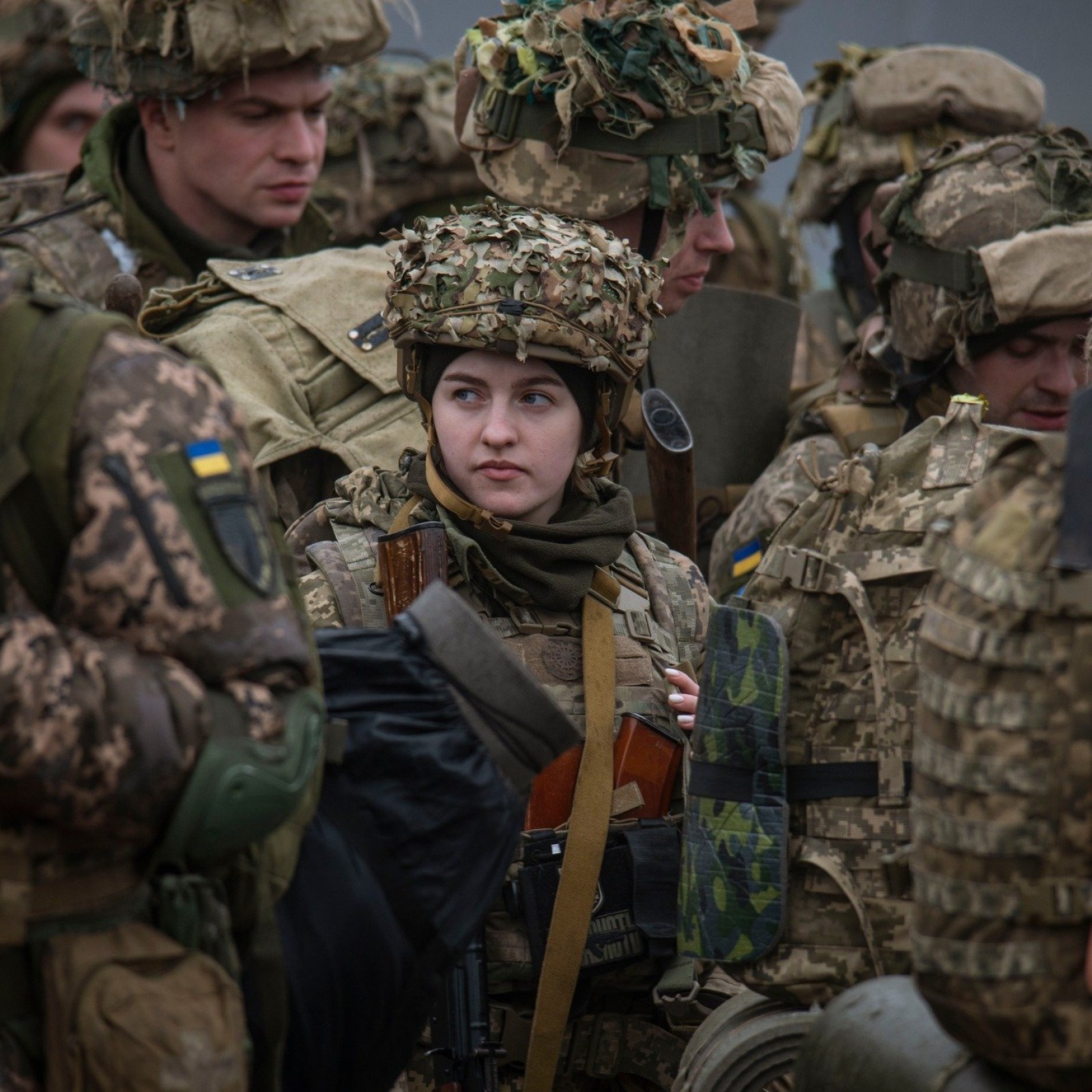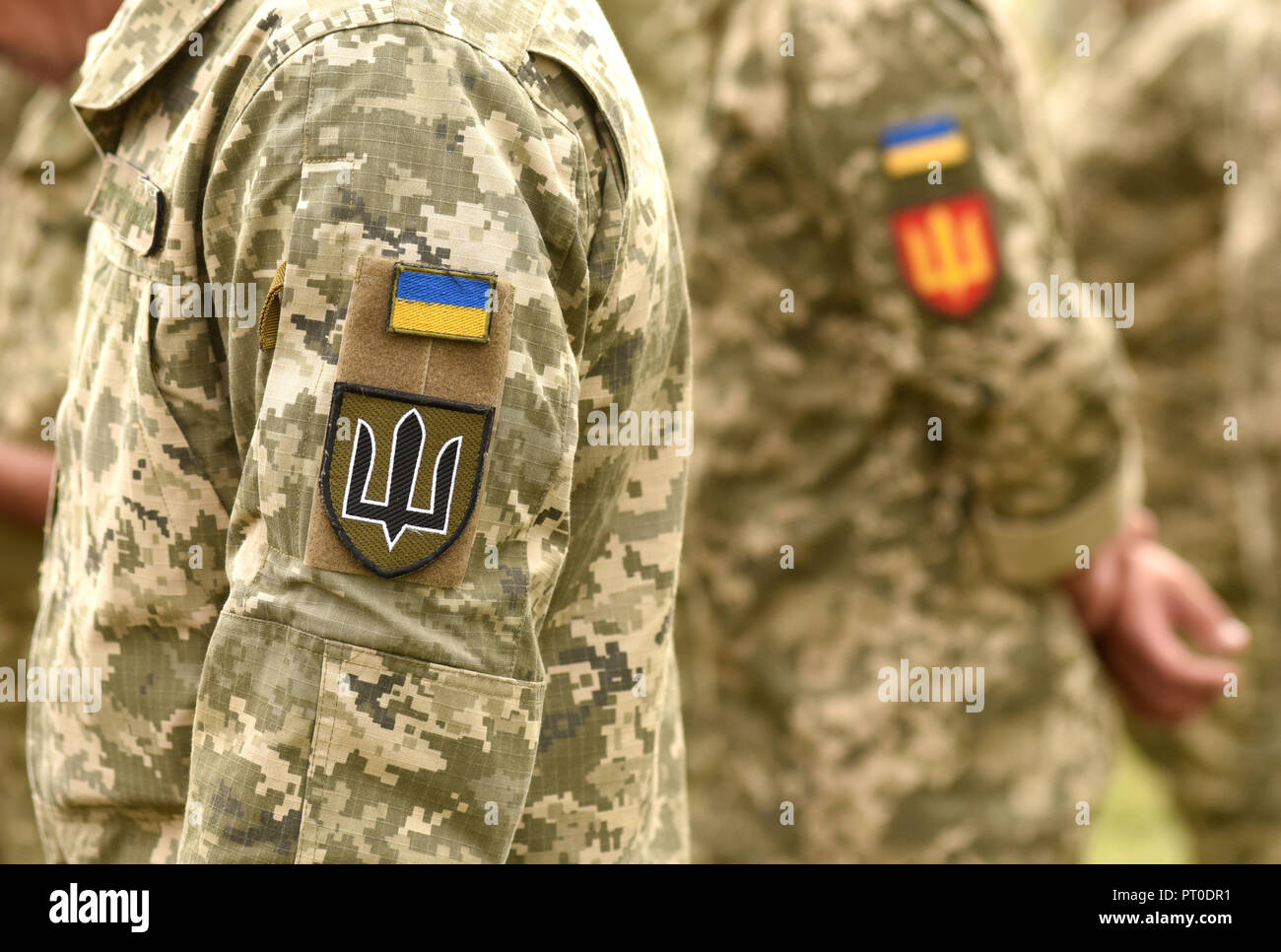Ukrainian Military Symbols - "As part of an International Women's Day collage for social media, we posted an image from stock footage of an international agency," a NATO official told Newsweek. "The post was removed when we realised it contained a symbol that we could not verify as official."
In the days leading up to Russia’s full-scale attack on Ukraine, several pictures and videos emerged on social media showing Russian tanks and other military equipment that appear to have the Latin letter “Z” painted on them in white.
Ukrainian Military Symbols

But former Marine Capt. Rob Lee, who spent a year with a defense-focused think tank in Moscow, said he does not believe the “Z” markings are intended to prevent fratricide because they are relatively small and hard to see at a distance.
"While that symbol can be found in an SS context, as an ornament in the Wewelsburg castle, its interpretation as the 'Black Sun' is not historical but a late post-war invention," Strube said. "Today, it serves as an identity marker for far-right circles."
In Ukraine, the emoji of the country's flag became a powerful symbol on social media. Some of the Ukrainians have also used the phrase used by soldiers defending the Snake Island: “Russian warship, go f*** yourself”.
Moscow has also alleged that nationalists such as those of the Azov Regiment were holding civilians hostage in cities under siege by Russian forces, blocking humanitarian corridors Russian troops have been accused of firing upon, and occupying a maternity hospital that Russian jets are accused of bombing in the city of Mariupol.
An unconfirmed rumor circulating on Russian social media is that Russian vehicles marked with the “Z’s” are intended to advance toward the Ukrainian city of Kharkiv, while columns bearing triangle markings could move west of the Donets Basin, he said.

But these same analysts took exception to what they unanimously deemed "propaganda" espoused by Russian President Vladimir Putin in his justification to launch a "special military operation" to achieve the "denazification" of Ukraine. And while the far-right played a role in the Euromaidan protests, it did so alongside a far broader segment of Ukrainian society seeking to geopolitically distance the country from neighboring Russia.
Newsweek has reported on the presence of far-right and even neo-Nazi elements within the Ukrainian military and among paramilitary formations, and has spoken with experts and former officials who raised the alarm about their presence and access to Western military support both before and after the outbreak of the war late last month.
"After the fall of the Third Reich, neo-Nazis (and, later, other white supremacists as well) adopted many symbols used or appropriated by the Nazis, including their version of the sonnenrad," Pitcavage told Newsweek. "In the past six years or so, it has become more popular among them, as symbols sometimes do. It is now incorporated in many white supremacist graphics, as well as in tattoos."
If U.S. military leaders know what the “Z” markings mean, they are keeping that information to themselves. Scott Ghiringhelli, a spokesman for U.S. European Command, said command officials do not discuss intelligence and neither confirm nor speculate about military plans and operations.
By Jeff Schogol | Updated Feb 24, 2022 9:42 AM EST
Lee noted that different versions of the markings have appeared in pictures, including the “Z” in a square, circle, or triangle — and some vehicles are marked solely with a triangle. Now that the invasion is underway, these different types of markings should allow Russian road guards directing traffic to make sure that a unit’s vehicles and equipment all go to the right place.

"There are no guarantees that the atmosphere of psychosis and hatred created in Europe will not push local nationalists to some irreparable acts," Russian Foreign Ministry spokesperson Maria Zakharova told a press briefing Wednesday. "Can you imagine how your hysteria, carefully created and disseminated in the media, will affect people with extreme, extremist views?
"It can refer to a supposed 'Pagan' past allegedly linked to Nazism and the SS in particular," Strube said. "As such, it might be related to Norse or Slavic Neo-Perunism with a far-right thrust — or it may simply serve as a substitute for the Nazi swastika, which is outlawed in several countries."
"During the nine years of occupation, Russia did everything to destroy the Ukrainian resistance in Crimea, imprisoning and kidnapping those who remained loyal to their state. But despite everything, the resistance on the peninsula is only getting stronger," says Tamila Tasheva, Permanent Representative of the President of Ukraine in the Autonomous Republic of Crimea.
“Bottom line is the ‘Z’ markings (and others like it) are a deconfliction measure to help prevent fratricide, or friendly fire incidents,” said Air Force Lt. Col. Tyson Wetzel, senior Air Force fellow with The Atlantic Council think tank in Washington, D.C. Because Russian warplanes, such as SU-25 Frogfoots and SU-34 Fullbacks, fly too quickly for their pilots to recognize the “Z” markings, these symbols are more likely meant to deter fratricide from Russian attack helicopters, artillery, rocket launchers, and mortars, Wetzel said.
Jeff Schogol is the senior Pentagon reporter for Task & Purpose. He has covered the military for 15 years. You can email him at schogol@taskandpurpose.com, direct message @JeffSchogol on Twitter, or reach him on WhatsApp and Signal at 703-909-6488. Contact the author here.
Retired Army Lt. Gen. Ben Hodges, former commander of U.S. Army Europe, said that while he does not know what the “Z” markings mean, the 101st Airborne Division used symbols from playing cards to identify its four regiments during World War II. For example, soldiers with the 506th Parachute Infantry Regiment painted spades on their helmets.

An official of the U.S.-led NATO alliance has told Newsweek that the coalition did not notice what appeared to be a symbol associated with Nazism on the uniform of a Ukrainian soldier featured in a since-deleted photo on NATO's official Twitter account.
In the context of Ukraine, where official symbols of both Nazism and communism were declared illegal in 2015, Strube said that the Black Sun is "most likely related or refers to the Azov Battalion, which used it among its insignia."
The image first appeared to be shared on social media on February 14 by the General Staff of the Armed Forces of Ukraine and was later syndicated by a number of outlets and agencies, and was featured prominently on the front page of The Guardian the following day. The symbol itself, however, is not readily visible, as it is nearly the same color as the green camouflage of the soldier's uniform.
Defense experts believe could be a way for Russian forces to distinguish their troops from the Ukrainians. Both sides use very similar military equipment and in the smoke of battle, a Russian T-72 main battle tank may look a lot like a Ukrainian T-80 through long-range sights.
Good catch from @BVasylchenko. Most of the "Z" markings seen thus far have been inside a square, but this Ural truck with a Msta-B howitzer has one inside a triangle. Possibly indicating different task forces within a larger formation or echelon. This is in Valuyki. https://t.co/cDAO4lEY7D pic.twitter.com/rJxxRul7GY
Defense officials have not said publicly what the markings could mean. It is also worth noting that the letter “Z” does not exist in the Russian alphabet, so perhaps the symbol is a version of the Cyrillic letter “I.”

"All women and girls must live free and equal. This international women's day we think of the remarkable women of #Ukraine," NATO tweeted alongside a Ukrainian flag emoji. "Their strength, bravery and resilience are symbolic of the spirit of their nation #IWD2022."
The first of the four images included what appeared to be a Ukrainian servicemember bearing a "Black Sun" on the chest area of her military fatigues. The symbol, also known in German as "Schwarze Sonne" or "Sonnenrad," is rooted in Nazi occultism and has been brandished by far-right elements across the globe, including in Ukraine, where it is featured on the official logo of the National Guard's Azov Regiment.
The Kremlin has issued four demands to Kyiv: the cessation of hostilities, recognition of the separatist Donetsk and Luhansk People's Republics, acknowledgment of Russia's control over Crimea, and a declaration of neutrality to remove Ukraine's bid to join NATO from the country's constitution.
"He is just destroying the citizens of Ukraine of different nationalities," the Ukrainian leader said Monday on a call with Jewish leaders. "This is just pure Nazi behavior. I can't even qualify this in any different manner."
And while Pitcavage explained that "sonnenrads or sunwheels are a common ancient symbol, used with many variations"—much in the way the swastika has ancient origins—he said "the Nazis created one specific variation that white supremacists have adopted." The Black Sun, he said "was one of the less common Nazi symbols, but because the SS used it, it gained a sort of elite status."
Russia on Tuesday launched a Soyuz rocket, which featured the letter “Z” in support of the military operation in Ukraine. The rocket was carrying the Meridian M communications satellite and was launched from the Plesetsk spaceport in Russia's far north, which is operated exclusively by the Defence Ministry.

Among the most prominent direct links to Nazism for the symbol was its display on the floor of the infamous Wewelsburg castle, used by Reichsführer-SS commander Heinrich Himmler. But as Strube emphasized, the Black Sun took on a life of its own in more recent decades.
The Ukrainian Defense Ministry did not immediately respond to Newsweek's request for comment. But Kyiv has roundly rejected such allegations, and Ukrainian President Volodymyr Zelensky, who is Jewish, has argued that it was Putin who was guilty of Nazi-style tactics on the ground and in the media.
Ukraine's own experience with Nazism has been the subject of great debate within the country and abroad. Ukraine was occupied by Nazi Germany from 1941 to 1944, and while some Ukrainians fought against the invaders, some nationalists, such as Stepan Bandera, who sought independence from the Soviet Union, chose to collaborate with Berlin against Moscow. Ukraine today considers both Nazi Germany's Holocaust and the Holomodor famine that took place under Soviet rule about a decade earlier to be genocides inflicted upon the Ukrainian people.
"The notion of the 'Black Sun' has been discussed in former and neo-Nazi circles since the 1950s, when it was related to alleged 'esoteric' SS circles and their super weapons that survived the war," Julian Strube, an assistant professor at the University of Vienna who has authored books on the subject, told Newsweek.